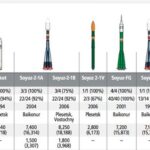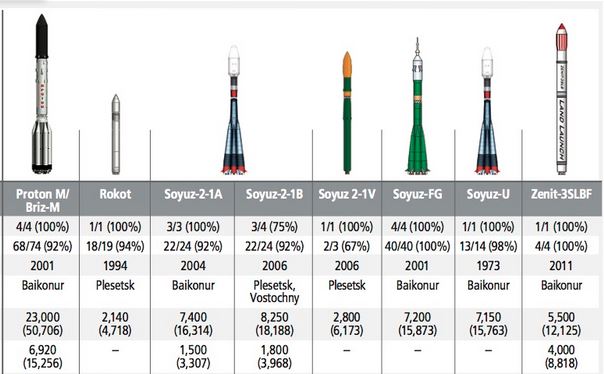Orbital Payload Launch
Russian Payload Launches
2017 – Russia Payload Launch – Snapshot


In 2017, Russia conducted 21% of global orbital launch attempts, a negligible increase from 20% in 2016. While its share of launch activities remained almost static, the country’s . . .
2016 – Russia Payload Launch – Snapshot
Russia abdicated its customary position as the world’s leader in the number of launches during 2016, coming in ## after the United States and China. The nation launched only ## space launch vehicles (SLVs), but still managed to hold ##% of the global launch market.
2015 – Russia Launch, Payload
Russia remained the world’s leader in number of launches provided during 2015, taking slightly more than 30% of the global orbital launch market for the year. This position was earned even though the nation’s launch rate fell by 19% to 26 launches in 2015, down from 32 launches during both 2013 and 2014. While Russia’s launch rate fell in 2015, Russia’s space launch system reliability fell slightly as well. Nearly 12% of Russia’s 26 launch attempts for the year were partial or total failures.
2014 – Russia Launch, Payload
Russia retained its position as the world’s most prolific orbital launch provider in 2014, a position it has maintained since 2004. Russia’s launch tempo in 2014 was the same as in 2013, with ## launch attempts, all of which were successful except for one Proton Space Launch Vehicle (SLV) with a Russian communications satellite aboard. Launch success does not always correspond to mission success, as in August 2014 when the Fregat upper stage of a Soyuz ST failed to position its two Galileo PNT satellites in the correct orbit. As of the end of 2014, the satellites’ operator, ESA, was still evaluating whether the satellites might be usable in altered orbits.
2013 – Russia Launch, Payload
Russia retained its position as the world’s most prolific orbital launch provider in 2013, a position that it has maintained since 2005. Although the Soviet Union was an extraordinarily prolific launcher, the difficulties caused by the collapse of the Soviet Union significantly curtailed Russian space activities for several years. Russia conducted ## orbital launches in 2013, of which ## were complete successes, ## total failure, and ## partial failure.
2012 – Russia Launch, Payload
Russia maintained its legacy as the world’s most prolific orbital launch operator in 2012. The Russian space program’s launches consisted mainly of cargo and crew transfer flights to the ISS and launches of commercial communications satellites. With little change anticipated in the amount of launch demand generated by these sources, Russia appears poised to retain its launch lead for the foreseeable future.
2011 – Russia’s Launch Efforts – Snapshot
Russia entered 2011 in the midst of an investigation into the loss of a Proton rocket carrying three Russian government navigation satellites in December 2010. Russian space officials scrambled to determine the cause of the loss, which was eventually determined to be the over-fueling of an upper stage. Problems continued to arise in 2011, leading to the loss of ## launch vehicles and the Phobos-Grunt mission to Mars. Nevertheless, Russia maintained its place as the world’s most-frequent launch provider with ## launches.
2010 – Russia’s Launch Effort – Snapshot
The Russian space program maintained its historically high launch rate while continuing development of its new spaceport and launch vehicles. Over the course of 2010, Russia conducted ## orbital launches, up from ## in 2009, using such longstanding vehicles as the Proton and Soyuz. Russia is developing ## new rocket systems to meet its needs for the future and is also working to launch the Soyuz 2 rocket from the existing European spaceport in Kourou, French Guiana.
2009 – Russia Launch and Payload – Snapshot
As in recent years, Russia led the world in orbital launches, with ## in 2009, sustaining a long history of pioneering space accomplishments. In 2009 Russia launched payloads on seven different vehicles: Kosmos, Cyclone, Dnepr, Proton, Rockot, Soyuz, and Soyuz 2.
2008 – Russia Launch, Payload
In each of the past five years from 2004 through 2008, Russia has led the world in the number of orbital launches. In 2008, Russia matched its 2007 launch rate, conducting ## orbital launches. Consistent with years past, nearly two-thirds of Russia’s 2008 launches used one of two vehicles, the Proton and Soyuz. Other Russian vehicles active in 2008 included the Dnepr, Kosmos 3M, Molniya, Rockot, and the Soyuz 2.